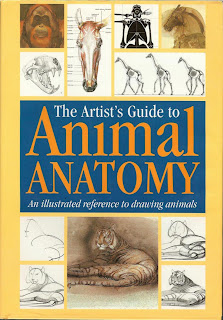I have a nineteen page listing of references that I've compiled from my own library, collected throughout my 20+ years of independent research on the subject of equine anatomy. But nineteen pages is a lot! So in keeping with the post about references and tidying up life, I'd like to share some hand-picked resources from that mammoth list that I believe are the Top Ten most useful for beginners.
These books were chosen for the novice sculptor because of their clarity and straight-forward treatment of the subject. Together, they create a solid platform for the beginner to starting understanding and visualizing equine anatomy under the skin. More still, they hint at more complex ideas in preparation for further study.
There are a few things I need to point out, however:
- These listings pertain only to anatomy, for the purpose of realistically sculpting the equine. Other aspects of realism, such as color genetics, are a whole 'nuther kettle o' fish that demand their own stage. For color genetics in particular, I recommend The Equine Tapestry as a super blog on the subject.
- Sculpting technique isn't offered, since that subject is so in-depth.
- Conformation references aren't offered, for too many reasons to go into here. Instead, I'll discuss the whys and hows in an upcoming post on the subject.
- Cost hasn't been indicated, so search the web for price comparisons.
- These resources aren't listed in any particular order, but they are meant to be digested together. No anatomical reference should be taken at face value, but used in partnership with others to make comparisons and train our brain to find patterns.
That said, always remember that the living animal is the best teacher. So please understand that, in addition to these recommendations, hours and hours...and hours...of field study are required homework. No amount of book smarts and no diagram or photo on the planet is going to compensate for inadequate "up close and personal" work. Ya gotta get yer shoes dirty! Anyway, enough babbling...let's get to it!
1. THE HORSE ANATOMY WORKBOOK. ISBN-10: 0-85131-905-X and ISBN-13: 978-0-85131-905-6. This book has clear drawings meant to be colored in to facilitate learning. It’s also spiral bound so it lies flat.
2. THE ARTIST’S GUIDE TO ANIMAL ANATOMY: AN ILLUSTRATED REFERENCE FOR DRAWING ANIMALS. 1994. ISBN: 0-7858-0055-7. Lots of illustrations that help to illuminate many basic biomechanical concepts, and planes of the body.
3. MODELING AND SCULPTING ANIMALS. 1985. ISBN: 0-486-25007-5. Has good line drawings, some that show unusual views, and they depict both sides!
4. SUPERFICIAL MUSCLES OF THE HORSE (chart). A quick, clear color-coordinated chart of the superficial muscles.
5. WIRE TO WHINNY. 3-day sculpting workshop instructed by Lynn Fraley.
6. ANIMAL PAINTING AND ANATOMY. 1975. ISBN: 0-486-22523-2. I've referred to this book so often, I just call it "Calderon." So read the text and study the drawings - then read and study again. The author’s observations are helpful for training your eye, and a helpful trick is to color-pencil-in the muscles as you read about them.
7. CYCLOPEDIA ANATOMICAE. 1996. ISBN: 1-884822-87-8. Lots of insights on all sorts of animal and human anatomy, but the horse ones are quite helpful for visualizing anatomy under the skin, and in motion.
8. EQUINE MASSAGE: A Practical Guide. 1997. ISBN: 0-87605-998-1. While this book obviously deals with massage, it has a lot of good basic anatomical information, plus guidance on how to palpate the horse for skeletal landmarks.
9. THE HORSE’S MUSCLES IN MOTION. 2002. ISBN: 1-86126-456-9. Translates the bones, joints and muscles into simplified mechanical-metaphor illustrations that clarify the basics quite well. Makes a good companion to Animal Painting and Anatomy, #6.
10. THE COLORING ATLAS OF HORSE ANATOMY. 1994. ISBN: 0-931866-69-3. Lots of clear illustrations for quick reference. Color them in, too! It also has some good, albeit brief, discussion on specific subjects, such as the stay apparatus.
So there ya go. Take your time digesting these resources, and most of all, go out to the pasture and start applying what you've learned. Don't be afraid to take photos or make sketches, either. It's also a handy trick to print your photos on paper, and draw in the bones and muscles on top of the printed image.
Our brains learn in different ways, so customize the experiences to suit your neural needs. Learning is fun! Ask questions, dig for the reasons why and how. You also may want to check out your local library or online resources to expand your understanding. The more you learn, the more questions you unearth...it's like a treasure hunt!
So for that purpose, I'll recommend the Top Ten references for intermediate sculptors in the next post!
"Who questions much, shall learn much, and retain much." ~ Sir Francis Bacon
Our brains learn in different ways, so customize the experiences to suit your neural needs. Learning is fun! Ask questions, dig for the reasons why and how. You also may want to check out your local library or online resources to expand your understanding. The more you learn, the more questions you unearth...it's like a treasure hunt!
So for that purpose, I'll recommend the Top Ten references for intermediate sculptors in the next post!





















